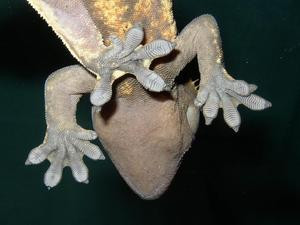The gecko's paw device suggested a solution for perfect grip for the legs of the robot
 Nature again suggests solutions to designers. Gecko paws 60 years ago already prompted tire engineers to find tire tread patterns (Lamels). Now, Stanford mechanical engineer Mark Kutkoski used material based on the construction of gecko paws to create a Stickybot robot that can climb onto any surface.
Nature again suggests solutions to designers. Gecko paws 60 years ago already prompted tire engineers to find tire tread patterns (Lamels). Now, Stanford mechanical engineer Mark Kutkoski used material based on the construction of gecko paws to create a Stickybot robot that can climb onto any surface. Just as a small reptile can scramble vertically on smooth glass, Stickybot can climb smooth surfaces thanks to the arrangement of legs created in the image of complex gecko paws.
 Mark Kutkoski, Stickybot’s lead designer, professor of mechanical engineering and co-director of the Center for Engineering, has collaborated with scientists across the country for the past five years to build such robots.
Mark Kutkoski, Stickybot’s lead designer, professor of mechanical engineering and co-director of the Center for Engineering, has collaborated with scientists across the country for the past five years to build such robots.After developing robots that could climb rough vertical surfaces, such as brick walls and concrete, Kutkosky switched to smooth surfaces such as glass and metal. And then he remembered the geckos: “In addition to the slow and inefficient suction cup method, another solution is to use the dry hitch that the geckos use.”
The wonders of the gecko
The gecko's toes contain hundreds of valve-shaped ribs called lamellae. Each rib has millions of bristles that are 10 times thinner than human hair. Under the microscope, you can see that each hair is divided into smaller strands called spatulae, which makes them look like split ends. These filaments are so tiny (several hundred nanometers) that they interact with surface molecules.
The interaction between the molecules of the strands of the gecko's paws and the surface causes a molecular attraction, called Van der Waals forces . A gecko can hang and hold all its weight on one paw, pressing it against the glass, and then easily detaching it. They only hold if you pull in one direction - their fingers are a kind of one-sided adhesive, ”says Kutkossky.
Gecko Robots
This method is important because it does not require much effort to attach and unfasten the leg of the robot.
“Other methods are like walking with chewing gum on your feet: you have to make an effort to squeeze your foot and then as much effort to tear it off. This method is similar to hooking and unhooking, ”says Mark.
After realizing this, Kutkossky and his team wondered how to get artificial materials for robots with the same effect. They tried with rubber-like material with miniature polymer hairs made from mold.
The designers placed this material on the legs of the robot, which are the size of a child’s hand, and the robot could easily climb surfaces, resembling a mechanical lizard.
The newest versions developed in 2009 have a two-level system similar to lamellas and gecko bristles. "Hair" has become even thinner than in the first embodiment - about 20 microns, which is five times thinner than human hair. These versions withstand even higher loads and allow Stickybot to climb surfaces such as boards, glass and metal.
Such robots can be useful for accessing dangerous or inaccessible places.
Future
A new task for the team is to expand the use of material for human use. The technology, called Z-Man, is already under development.
Kutkossky and his team are also working on a new version of Stickybot, which will be able to rotate during lifting: since the material clings in only one direction, it is necessary to rotate the legs to rotate. To do this, he will have rotating ankles, like geckos. Take a look at the legs of a gecko descending upside down - they are upside down. It should be so, otherwise it will fall.
This project is funded by the National Science Foundation and the Department of Defense Advanced Defense Research Projects Agency (DARPA). The studies are described in an article published on August 2 in Applied Physics Letters - “The Effect of the Form of Fibrils on Adhesive Properties”.
Source: Stanford News Service
